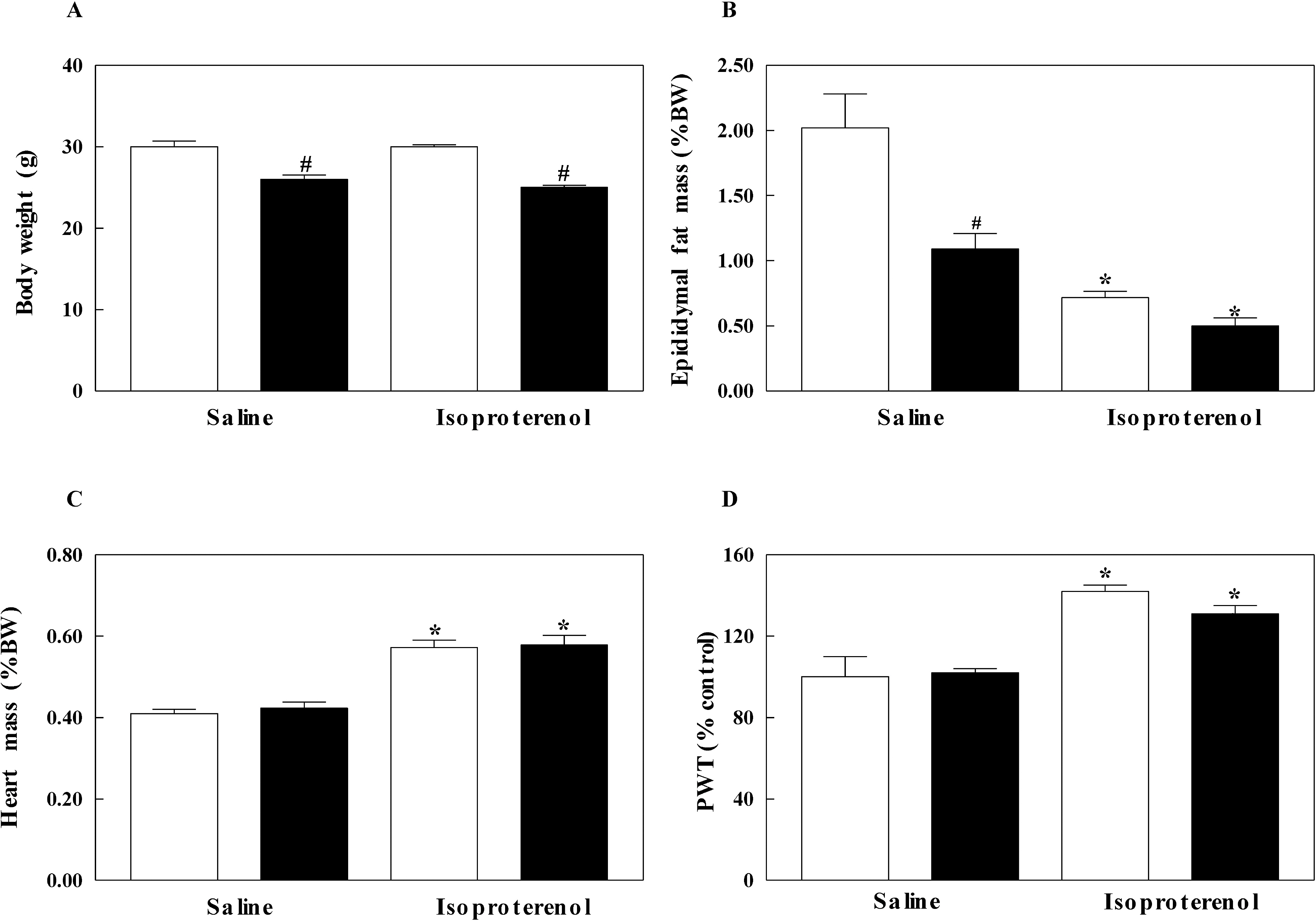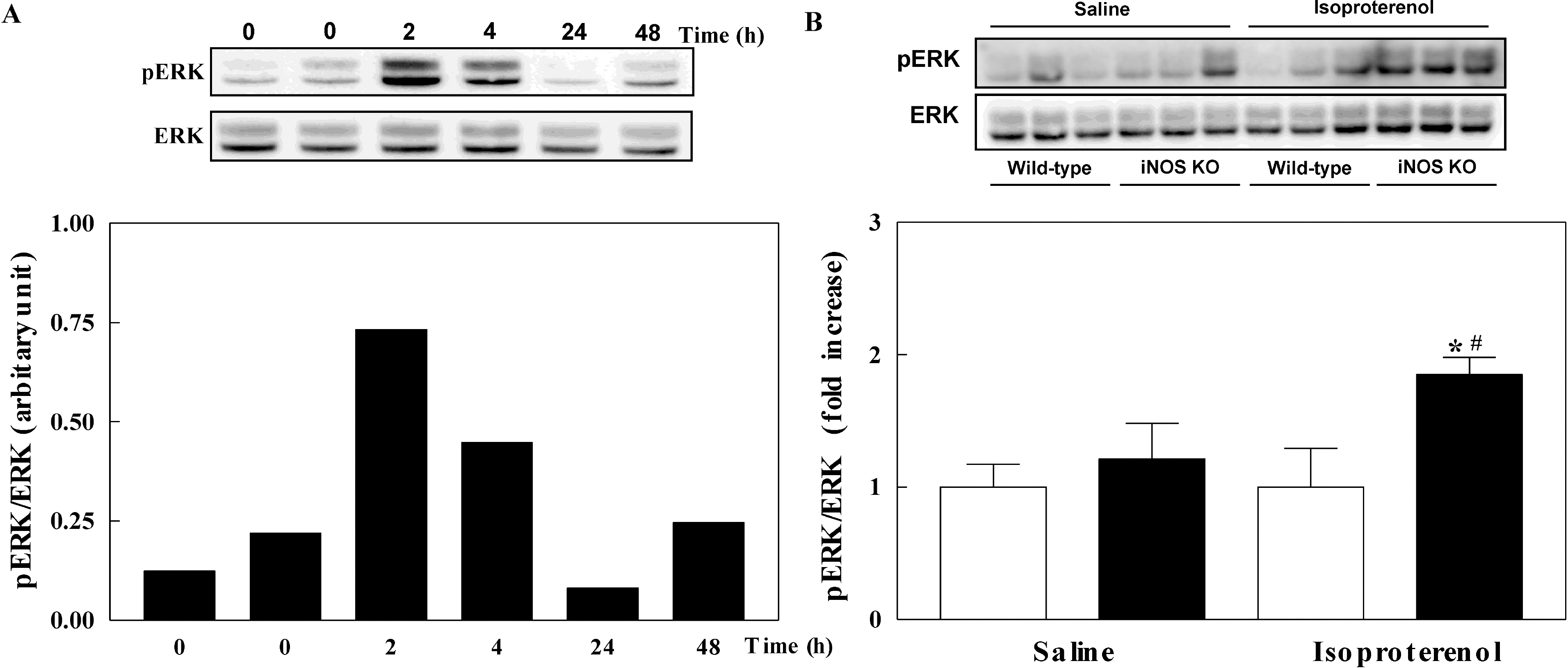Korean J Physiol Pharmacol.
2009 Jun;13(3):153-159. 10.4196/kjpp.2009.13.3.153.
Deficiency of iNOS Does Not Prevent Isoproterenol-induced Cardiac Hypertrophy in Mice
- Affiliations
-
- 1Department of Physiology, College of Medicine, Yeungnam University, Daegu 705-717, Korea. sypark@med.yu.ac.kr
- 2Aging-associated Vascular Disease Research Center, College of Medicine, Yeungnam University, Daegu 705-717, Korea.
- 3Division of Cardiology, Department of Internal Medicine, College of Medicine, Yeungnam University, Daegu 705-717, Korea.
- 4Department of Orthopedic Surgery, Gumi CHA University Hospital, Gumi 730-728, Korea.
- KMID: 2071665
- DOI: http://doi.org/10.4196/kjpp.2009.13.3.153
Abstract
- We investigated whether deficiency of inducible nitric oxide synthase (iNOS) could prevent isoproterenol-induced cardiac hypertrophy in iNOS knockout (KO) mice. Isoproterenol was continuously infused subcutaneously (15 mg/kg/day) using an osmotic minipump. Isoproterenol reduced body weight and fat mass in both iNOS KO and wild-type mice compared with saline-infused wild-type mice. Isoproterenol increased the heart weight in both iNOS KO and wild-type mice but there was no difference between iNOS KO and wild-type mice. Posterior wall thickness of left ventricle showed the same tendency with heart weight. Protein level of iNOS in the left ventricle was increased in isoproterenol-infused wild-type mice. The gene expression of interleukin-6 (IL-6) and transforming growth factor-beta (TGF-beta) in isoproterenol-infused wild-type was measured at 2, 4, 24, and 48-hour and isoproterenol increased both IL-6 (2, 4, 24, and 48-hour) and TGF-beta (4 and 24-hour). Isoproterenol infusion for 7 days increased the mRNA level of IL-6 and TGF-beta in iNOS KO mice, whereas the gene expression in wild-type mice was not increased. Phosphorylated form of extracellular signal-regulated kinases (pERK) was also increased by isoproterenol at 2 and 4-hour but was not increased at 7 days after infusion in wild-type mice. However, the increased pERK level in iNOS KO mice was maintained even at 7 days after isoproterenol infusion. These results suggest that deficiency of iNOS does not prevent isoproterenol-induced cardiac hypertrophy and may have potentially harmful effects on cardiac hypertrophy.
MeSH Terms
-
Animals
Body Weight
Cardiomegaly
Extracellular Signal-Regulated MAP Kinases
Gene Expression
Heart
Heart Ventricles
Interleukin-6
Isoproterenol
Mice
Nitric Oxide Synthase Type II
RNA, Messenger
Transforming Growth Factor beta
Extracellular Signal-Regulated MAP Kinases
Interleukin-6
Isoproterenol
Nitric Oxide Synthase Type II
RNA, Messenger
Transforming Growth Factor beta
Figure
Cited by 2 articles
-
Inhibition of Inducible Nitric Oxide Synthase Attenuates Monosodium Urate-induced Inflammation in Mice
Tae-Jin Ju, Jin-Myoung Dan, Young-Je Cho, So-Young Park
Korean J Physiol Pharmacol. 2011;15(6):363-369. doi: 10.4196/kjpp.2011.15.6.363.Metformin Inhibits Isoproterenol-induced Cardiac Hypertrophy in Mice
Hye-Na Cha, Jung Hyun Choi, Yong-Woon Kim, Jong-Yeon Kim, Myun-Whan Ahn, So-Young Park
Korean J Physiol Pharmacol. 2010;14(6):377-384. doi: 10.4196/kjpp.2010.14.6.377.
Reference
-
Barry SP., Davidson SM., Townsend PA. Molecular regulation of cardiac hypertrophy. Int J Biochem Cell Biol. 40:2023–2039. 2008.
ArticleBoluyt MO., O'Neill L., Meredith AL., Bing OH., Brooks WW., Conrad CH., Crow MT., Lakatta EG. Alterations in cardiac gene expression during the transition from stable hypertrophy to heart failure. Marked upregulation of genes encoding extracellular matrix components. Circ Res. 75:23–32. 1994.
ArticleBueno OF., Molkentin JD. Involvement of extracellular signal-regulated kinases 1/2 in cardiac hypertrophy and cell death. Circ Res. 91:776–781. 2002.
ArticleCha H. The Effect of iNOS deficiency on age-associated insulin resistance. MS Thesis. 2009.Cmungrue IN., Gros R., You X., Pirani A., Azad A., Csont T., Schulz R., Butany J., Stewart DJ., Husain M. Cardiomyocyte over-expression of iNOS in mice results in peroxynitrite generation, heart block, and sudden death. J Clin Invest. 109:735–743. 2002.Collins S., Surwit RS. The beta-adrenergic receptors and the control of adipose tissue metabolism and thermogenesis. Recent Prog Horm Res. 56:309–328. 2001.Funakoshi H., Kubota T., Kawamura N., Machida Y., Feldman AM., Tsutsui H., Shimokawa H., Takeshita A. Disruption of inducible nitric oxide synthase improves beta-adrenergic inotropic responsiveness but not the survival of mice with cytokine-induced cardiomyopathy. Circ Res. 90:959–965. 2002.Gardner DG., Chen S., Glenn DJ., Grigsby CL. Molecular biology of the natriuretic peptide system: implications for physiology and hypertension. Hypertension. 49:419–426. 2007.Godecke A., Molojavyi A., Heger J., Flogel U., Ding Z., Jacoby C., Schrader J. Myoglobin protects the heart from inducible nitric-oxide synthase (iNOS)-mediated nitrosative stress. J Biol Chem. 278:21761–21766. 2003.Greenwood JP., Scott EM., Stoker JB., Mary DA. Hypertensive left ventricular hypertrophy: relation to peripheral sympathetic drive. J Am Coll Cardiol. 38:1711–1717. 2001.
ArticleIKodama H., Fukuda K., Pan J., Sano M., Takahashi T., Kato T., Makino S., Manabe T., Murata M., Ogawa S. Significance of ERK cascade compared with JAK/STAT and PI3-K pathway in gp130-mediated cardiac hypertrophy. Am J Physiol Heart Circ Physiol. 279:H1635–1644. 2000.Imamura G., Bertelli AA., Bertelli A., Otani H., Maulik N., Das DK. Pharmacological preconditioning with resveratrol: an insight with iNOS knockout mice. Am J Physiol Heart Circ Physiol. 282:H1996–2003. 2002.Ji K., Minakawa M., Fukui K., Suzuki Y., Fukuda I. Increased superoxide radical with a decrease in vascular endothelial growth factor and inducible nitric oxide synthase level leads to the progression of left ventricular hypertrophy in a pressure-overload rat heart model. Ann Thorac Cardiovasc Surg. 14:210–217. 2008.Kelly RA., Balligand JL., Smith TW. Nitric oxide and cardiac function. Circ Res. 79:363–380. 1996.
ArticleKrenek P., Kmecova J., Kucerova D., Bajuszova Z., Musil P., Gazova A., Ochodnicky P., Klimas J., Kyselovic J. Isoproterenol-induced heart failure in the rat is associated with nitric oxide-dependent functional alterations of cardiac function. Eur J Heart Fail. 11:140–146. 2009.
ArticleKundu S., Kumar M., Sen U., Mishra PK., Tyagi N., Metreveli N., Lominadze D., Rodriguez W., Tyagi SC. Nitrotyrosinylation, remodeling and endothelial-myocyte uncoupling in iNOS, cystathionine beta synthase (CBS) knockouts and iNOS/CBS double knockout mice. J Cell Biochem. 106:119–126. 2009.
ArticleLevy D., Garrison RJ., Savage DD., Kannel WB., Castelli WP. Prognostic implications of echocardiographically determined left ventricular mass in the framingham heart study. N Engl J Med. 322:1561–1566. 1990.
ArticleLi RK., Li G., Mickle DA., Weisel RD., Merante F., Luss H., Rao V., Christakis GT., Williams WG. Overexpression of transforming growth factor-beta1 and insulin-like growth factor-I in patients with idiopathic hypertrophic cardiomyopathy. Circulation. 96:874–881. 1997.Mikaelian I., Coluccio D., Morgan KT., Johnson T., Ryan AL., Rasmussen E., Nicklaus R., Kanwal C., Hilton H., Frank K., Fritzky L., Wheeldon EB. Temporal gene expression profiling indicates early up-regulation of interleukin-6 in isoproterenol-induced myocardial necrosis in rat. Toxicol Pathol. 36:256–264. 2008.
ArticleOsadchii OE. Cardiac hypertrophy induced by sustained beta-adrenoreceptor activation: pathophysiological aspects. Heart Fail Rev. 12:66–86. 2007.Pauschinger M., Knopf D., Petschauer S., Doerner A., Poller W., Schwimmbeck PL., Kuhl U., Schultheiss HP. Dilated cardiomyopathy is associated with significant changes in collagen type I/III ratio. Circulation. 99:2750–2756. 1999.
ArticlePelat M., Verwaerde P., Galitzky J., Lafontan M., Berlan M., Senard JM., Montastruc JL. High isoproterenol doses are required to activate beta3-adrenoceptor-mediated functions in dogs. J Pharmacol Exp Ther. 304:246–253. 2003.Rajabi M., Kassiotis C., Razeghi P., Taegtmeyer H. Return to the fetal gene program protects the stressed heart: a strong hypothesis. Heart Fail Rev. 12:331–343. 2007.
ArticleSchlaich MP., Kaye DM., Lambert E., Sommerville M., Socratous F., Esler MD. Relation between cardiac sympathetic activity and hypertensive left ventricular hypertrophy. Circulation. 108:560–565. 2003.
ArticleStrand AH., Gudmundsdottir H., Os I., Smith G., Westheim AS., Bjornerheim R., Kjeldsen SE. Arterial plasma noradrenaline predicts left ventricular mass independently of blood pressure and body build in men who develop hypertension over 20 years. J Hypertens. 24:905–913. 2006.
ArticleSzabo J., Csaky L., Szegi J. Experimental cardiac hypertrophy induced by isoproterenol in the rat. Acta Physiol Acad Sci Hung. 46:281–285. 1975.Tanaka T., Kanda T., Itoh T., Tsugawa H., Takekoshi N., Yamakawa J., Kurimoto M., Kurabayashi M. Increased cardiac weight in interleukin-6 transgenic mice with viral infection accompanies impaired expression of natriuretic peptide genes. Res Commun Mol Pathol Pharmacol. 110:275–283. 2001.Tsuchiya K., Sakai H., Suzuki N., Iwashima F., Yoshimoto T., Shichiri M., Hirata Y. Chronic blockade of nitric oxide synthesis reduces adiposity and improves insulin resistance in high fat-induced obese mice. Endocrinology. 148:4548–4556. 2007.
ArticleVillarreal FJ., Dillmann WH. Cardiac hypertrophy-induced changes in mRNA levels for TGF-beta 1, fibronectin, and collagen. Am J Physiol. 262:H1861–1866. 1992.
ArticleWang T., Yan M., Li J., Zheng X. The role of iNOS-derived NO in the antihypertrophic actions of B-type natriuretic peptide in neonatal rat cardiomyocytes. Mol Cell Biochem. 302:169–177. 2007.
ArticleXi L., Jarrett NC., Hess ML., Kukreja RC. Essential role of inducible nitric oxide synthase in monophosphoryl lipid A-induced late cardioprotection: evidence from pharmacological inhibition and gene knockout mice. Circulation. 99:2157–2163. 1999.Zhang GX., Kimura S., Nishiyama A., Shokoji T., Rahman M., Yao L., Nagai Y., Fujisawa Y., Miyatake A., Abe Y. Cardiac oxidative stress in acute and chronic isoproterenol-infused rats. Cardiovasc Res. 65:230–238. 2005.
ArticleZhang J., Knapton A., Lipshultz SE., Weaver JL., Herman EH. Isoproterenol-induced cardiotoxicity in sprague-dawley rats: correlation of reversible and irreversible myocardial injury with release of cardiac troponin T and roles of iNOS in myocardial injury. Toxicol Pathol. 36:277–278. 2008.
ArticleZhang P., Xu X., Hu X., van Deel ED., Zhu G., Chen Y. Inducible nitric oxide synthase deficiency protects the heart from systolic overload-induced ventricular hypertrophy and congestive heart failure. Circ Res. 100:1089–1098. 2007.
ArticleZingarelli B., Hake PW., Yang Z., O'Connor M., Denenberg A., Wong HR. Absence of inducible nitric oxide synthase modulates early reperfusion-induced NF-kappaB and AP-1 activation and enhances myocardial damage. Faseb J. 16:327–342. 2002.
- Full Text Links
- Actions
-
Cited
- CITED
-
- Close
- Share
- Similar articles
-
- The alteration of Ca2+-activated K+ channels in coronary arterial smooth muscle cells isolated from isoproterenol-induced cardiac hypertrophy in rabbit
- Altered delayed rectifier K+ current of rabbit coronary arterial myocytes in isoproterenol-induced hypertrophy
- Metformin Inhibits Isoproterenol-induced Cardiac Hypertrophy in Mice
- Differential Activation of Ras/Raf/MAPK Pathway between Heart and Cerebral Artery in Isoproterenol-induced Cardiac Hypertrophy
- Expression of natriuretic peptide mRNAs in isoproterenol-induced cardiac hypertrophy in rats.





